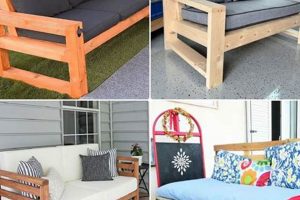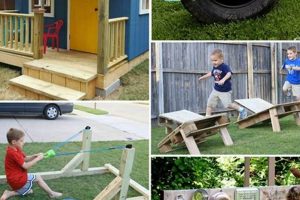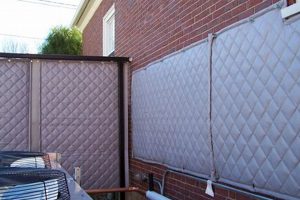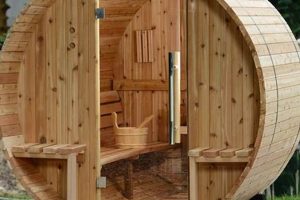Construction of exterior furnishings from reclaimed wooden platforms represents an accessible and cost-effective approach to enhancing outdoor living spaces. These platforms, commonly used for transporting goods, can be disassembled and repurposed to create a variety of functional and aesthetically pleasing items. Examples include seating arrangements, tables, and even outdoor beds.
The significance of this approach lies in its ability to promote resourcefulness and sustainability by diverting materials from landfills. Furthermore, it offers economic advantages, as the primary material is often obtainable at minimal or no cost. Historically, the practice of repurposing materials has been prevalent across cultures, reflecting a commitment to frugality and environmental consciousness. This particular application extends that tradition, empowering individuals to customize their environments while minimizing their ecological footprint.
This article will explore the diverse applications of reclaimed platform materials in outdoor furnishing, outlining necessary safety precautions, detailing construction techniques, and providing guidance on finishing and weatherproofing to ensure longevity and aesthetic appeal of the finished products.
Essential Guidance for Platform-Based Exterior Furnishings
The following recommendations are designed to enhance the safety, durability, and aesthetic quality of outdoor furniture constructed from repurposed wooden platforms. Adherence to these guidelines will contribute to the creation of functional and visually appealing exterior spaces.
Tip 1: Material Selection: Prioritize platforms stamped with an “HT” marking, indicating heat treatment rather than chemical treatment. Chemical treatments can pose health risks, particularly in outdoor environments where exposure is prolonged.
Tip 2: Structural Integrity Assessment: Thoroughly inspect each platform for signs of damage, including cracks, rot, and insect infestation. Compromised structural elements should be discarded to ensure the stability and safety of the finished furniture.
Tip 3: Disassembly Protocol: Exercise caution during disassembly, employing appropriate safety gear such as gloves and eye protection. Utilize the correct tools to minimize the risk of injury and damage to the wood.
Tip 4: Surface Preparation: Sanding is crucial for creating a smooth surface and removing splinters. Start with a coarse grit sandpaper and progressively move to finer grits for a polished finish.
Tip 5: Joint Reinforcement: Strengthen joints with wood glue and screws or nails to ensure long-term stability, especially for weight-bearing components such as seating and table legs. Consider using metal brackets for added support.
Tip 6: Weatherproofing Techniques: Apply a high-quality exterior wood sealant or paint to protect the furniture from moisture, UV rays, and temperature fluctuations. Multiple coats may be necessary for optimal protection.
Tip 7: Design Considerations: Plan the design carefully, considering ergonomics and functionality. Ensure that seating is appropriately sized and angled for comfort, and that tables provide adequate surface area.
These recommendations emphasize the importance of meticulous planning, careful execution, and the selection of appropriate materials and techniques to maximize the lifespan and utility of exterior furnishings crafted from reclaimed wooden platforms.
The subsequent section will address specific project ideas and design inspirations for utilizing repurposed platforms in creating unique outdoor furniture pieces.
1. Platform Sourcing
The origin of wooden platforms directly dictates the feasibility, safety, and overall quality of subsequent exterior furnishings projects. The type of wood, its prior use, and any treatments applied during its initial purpose significantly affect its suitability for repurposing. For example, platforms that have carried hazardous materials or those treated with methyl bromide are unsuitable due to potential health risks. Conversely, platforms used for dry goods and stamped with an “HT” mark, indicating heat treatment, are generally considered safer for reuse. The selection of appropriate platforms, therefore, is not merely a matter of convenience but a fundamental safety consideration.
The sourcing process also impacts the structural integrity of the finished furniture. Platforms subjected to excessive wear and tear during their initial usage may exhibit weakened boards, loose connections, or rot, rendering them unsuitable for load-bearing applications. A rigorous inspection process is therefore essential. Sourcing from reliable suppliers who understand the intended use and can vouch for the platform’s condition is highly advantageous. Consider, for instance, businesses receiving regular deliveries that discard platforms. These sources might offer consistent supplies and a degree of assurance regarding the platform’s history.
Ultimately, responsible platform sourcing ensures the longevity and safety of exterior furnishings. Neglecting this crucial initial step can lead to structural failures, potential health hazards, and increased material waste. Thoughtful platform sourcing, therefore, represents a foundational element in the responsible creation of durable and aesthetically pleasing outdoor furniture from repurposed wooden platforms.
2. Structural Integrity
Structural integrity is paramount in the construction of exterior furnishings from repurposed platforms. The inherent design of these platforms, intended for single-use load bearing, may not suffice for long-term furniture applications without careful assessment and reinforcement. Failure to ensure structural integrity can lead to premature failure, potential injury, and a significantly reduced lifespan for the finished product.
- Wood Condition and Selection
The initial condition of the wood used to construct the platform is critical. Platforms exhibiting signs of rot, insect infestation, or significant cracking are structurally compromised and unsuitable for furniture construction. Species of wood used also influences structural performance; hardwoods offer greater load-bearing capacity than softwoods. Discarding damaged wood and selecting appropriate materials constitutes the first step in ensuring the stability of exterior furniture created from reused platforms.
- Joint Strength and Reinforcement
The joints connecting the various components of a platform-based furniture piece are often the weakest points. Original nail or staple connections may loosen over time, particularly when exposed to outdoor elements. Reinforcing these joints with screws, bolts, or metal brackets is essential for enhancing overall structural stability. Adhesive application (exterior grade) also aids in strengthening these connections.
- Load Distribution and Support
Understanding how weight is distributed across the furniture piece is essential for reinforcing potential weak points. For seating, legs must be adequately sized and positioned to support the anticipated load. Incorporating internal bracing and support structures can distribute weight more evenly, preventing stress concentrations that could lead to failure. Proper load distribution ensures stability and prevents sagging or collapse.
- Environmental Considerations and Durability
Exterior environments pose significant challenges to structural integrity. Exposure to moisture, fluctuating temperatures, and sunlight can accelerate wood degradation and weaken joints. Applying weather-resistant finishes, such as sealants and paints, can protect the wood from the elements and prolong the lifespan of the furniture. Regular maintenance, including inspections for signs of damage and reapplication of protective coatings, is crucial for sustaining structural integrity over time.
The successful creation of durable and safe outdoor furniture from repurposed platforms hinges upon a comprehensive understanding of structural integrity principles. By carefully assessing material condition, reinforcing joints, optimizing load distribution, and mitigating environmental impacts, the lifespan and utility of these creations can be significantly extended, offering a sustainable and cost-effective alternative to commercially produced outdoor furnishings.
3. Design Adaptability
Design adaptability, in the context of constructing exterior furnishings from reclaimed wooden platforms, refers to the capacity to modify and customize the basic platform structure to suit specific functional requirements, aesthetic preferences, and spatial constraints. This adaptability is a crucial element that enhances the utility and appeal of platform-based outdoor furniture, transforming a standardized material into diverse and personalized pieces.
- Modular Construction and Reconfiguration
The modular nature of wooden platforms allows for flexible assembly and reconfiguration. Individual platform sections can be combined in various arrangements to create different furniture types, such as benches, tables, or sectionals. This modularity facilitates easy adaptation to varying outdoor spaces and allows for future modifications as needs evolve. For example, a simple bench can be extended by adding additional platform sections, or a table can be increased in size by incorporating more surface elements.
- Customization of Dimensions and Ergonomics
Platforms can be readily cut, reshaped, and reassembled to achieve specific dimensions and ergonomic considerations. Seat heights, backrest angles, and table sizes can be tailored to individual preferences and physical requirements. This customization ensures optimal comfort and functionality. For instance, adjusting the height of a platform-based chair to match a specific dining table or modifying the depth of a seating area to accommodate cushions and pillows demonstrates this aspect of design adaptability.
- Integration of Diverse Materials and Finishes
Platform structures can be seamlessly integrated with a wide range of materials and finishes to enhance aesthetics and durability. Metal legs, glass tabletops, fabric cushions, and exterior-grade paints or stains can be combined with the platform base to create unique and visually appealing furniture pieces. This integration allows for the realization of diverse design styles, from rustic to modern. Incorporating weather-resistant finishes, for example, not only protects the wood but also allows for the introduction of color and texture to complement the outdoor environment.
- Adaptive Reuse for Varied Functional Purposes
The inherent structure of a platform can be creatively adapted to serve multiple functional purposes beyond basic seating or tables. Platforms can be repurposed to create raised garden beds, outdoor storage solutions, or even decorative screens. This versatility maximizes the utility of the material and reduces waste. For instance, a platform can be transformed into a vertical garden by attaching planters to its sides, or it can be used to construct a storage bench with a hinged lid for concealing outdoor equipment.
In summary, design adaptability empowers creators to transform standardized wooden platforms into bespoke outdoor furniture that meets individual needs and preferences. This ability to modify, customize, and integrate various materials and functions significantly enhances the value and appeal of platform-based creations, promoting resourcefulness and personalized design in outdoor spaces.
4. Weather Protection
Exterior furniture constructed from repurposed wooden platforms is inherently susceptible to degradation from environmental factors. Exposure to moisture, ultraviolet (UV) radiation, and temperature fluctuations can compromise the structural integrity and aesthetic appeal of the wood. Moisture penetration promotes rot and decay, weakening the timber over time. UV radiation causes fading, discoloration, and surface cracking. Temperature variations induce expansion and contraction, stressing joints and fastenings. Therefore, effective weather protection is not merely an aesthetic consideration but a critical component for ensuring the longevity and safety of such furniture. For instance, an unprotected platform-based bench left outdoors will exhibit signs of deterioration within a single season, while a properly sealed and maintained piece can withstand several years of exposure.
Practical application of weather protection techniques involves several key steps. Firstly, the selection of appropriate wood sealants or paints is crucial. These coatings act as a barrier against moisture and UV radiation. Oil-based sealants penetrate the wood fibers, providing deep protection, while water-based options offer greater environmental friendliness and ease of application. Secondly, proper surface preparation is essential for optimal adhesion. Sanding removes existing imperfections and creates a textured surface for the sealant to bond to. Thirdly, regular maintenance is required to ensure continued protection. Reapplication of sealants or paints every one to two years, depending on environmental conditions, prevents the formation of cracks and keeps the furniture looking its best. An example would be a platform table regularly treated with teak oil, maintaining a rich color and preventing water damage from spilled drinks and rain.
Achieving adequate weather protection for platform-based exterior furniture presents several challenges, including the cost of high-quality sealants and the time commitment required for proper application and maintenance. However, the long-term benefits of increased durability and reduced repair costs outweigh these challenges. Understanding the mechanisms by which weather damages wood and implementing appropriate protective measures is paramount for creating sustainable and aesthetically pleasing outdoor furnishings from repurposed platforms. Neglecting weather protection undermines the entire project, rendering the furniture vulnerable and ultimately unsustainable.
5. Ergonomic Comfort
Ergonomic comfort is a crucial, yet often overlooked, component in the design and construction of exterior furniture from repurposed wooden platforms. The inherent characteristics of these platforms, such as their rigid structure and standardized dimensions, frequently necessitate modifications to ensure user comfort and prevent musculoskeletal strain. The absence of ergonomic considerations can lead to discomfort, fatigue, and even long-term health issues. For example, a platform-based bench with an excessively high or low seat height can cause strain on the knees and back. Similarly, a chair lacking proper lumbar support can contribute to back pain over extended periods of use. Ergonomic design directly influences the usability and enjoyment of outdoor spaces furnished with these repurposed materials. The practical significance of this understanding lies in promoting well-being and encouraging prolonged use of the furniture.
Achieving ergonomic comfort in platform-based furniture requires careful planning and execution. Seat height, backrest angle, and armrest placement must be precisely calculated and adjusted to accommodate a range of body sizes and postures. The addition of cushions and padding can significantly enhance comfort by providing cushioning and support in key areas. Furthermore, the integration of adjustable features, such as reclining backrests or adjustable seat heights, allows users to customize the furniture to their individual needs. A practical application of this principle is the construction of a platform-based lounge chair with an adjustable backrest, enabling users to recline at various angles for optimal relaxation. The incorporation of a contoured seat cushion can further enhance comfort by distributing weight evenly and reducing pressure points. Understanding anthropometric data and ergonomic principles is essential for creating furniture that is both functional and comfortable.
The challenges associated with incorporating ergonomic comfort into platform-based furniture primarily stem from the need to balance design considerations with the limitations imposed by the material. Adapting the rigid structure of a platform to accommodate ergonomic curves and contours often requires creative solutions and advanced woodworking techniques. However, the investment in ergonomic design is well worth the effort, as it directly impacts the usability, enjoyment, and long-term health benefits of the furniture. By prioritizing ergonomic comfort, creators can transform repurposed wooden platforms into functional and inviting outdoor spaces that promote relaxation, well-being, and sustainable living. Ignoring these principles can result in furniture that is visually appealing but ultimately uncomfortable and unusable.
Frequently Asked Questions
The following section addresses common inquiries and misconceptions regarding the construction and maintenance of outdoor furniture utilizing repurposed wooden platforms. Information presented is intended to provide clarity and promote informed decision-making.
Question 1: Are all platforms safe for repurposing into outdoor furniture?
No. Platforms treated with methyl bromide or those that have transported hazardous materials pose health risks and should not be repurposed. Platforms stamped with “HT,” indicating heat treatment, are generally considered safer. Always verify the platform’s history and treatment before use.
Question 2: How can the structural integrity of a platform be assessed?
Inspect the platform thoroughly for signs of rot, insect infestation, cracks, and loose connections. Test the stability of individual boards and joints. Discard any compromised materials. Reinforce weak points with screws, bolts, or metal brackets during construction.
Question 3: What type of sealant is most effective for weather protection?
Both oil-based and water-based sealants offer weather protection, though oil-based sealants typically provide deeper penetration and longer-lasting protection. Select a sealant specifically formulated for exterior use and follow the manufacturer’s instructions for application. Reapply sealant periodically, as needed.
Question 4: How can ergonomic comfort be incorporated into platform furniture?
Modify platform dimensions to suit ergonomic requirements. Adjust seat heights, backrest angles, and armrest placements for optimal comfort. Add cushions and padding for cushioning and support. Consider incorporating adjustable features, such as reclining backrests.
Question 5: What are the key considerations for preventing rot and decay in platform furniture?
Apply a high-quality exterior wood sealant or paint to protect the wood from moisture. Ensure proper drainage to prevent water from pooling on the furniture surface. Elevate the furniture slightly off the ground to improve airflow and reduce moisture contact. Regularly inspect the furniture for signs of rot and address any issues promptly.
Question 6: Is regular maintenance required for platform-based outdoor furniture?
Yes. Regular maintenance is essential for preserving the appearance and structural integrity of platform furniture. Clean the furniture periodically to remove dirt and debris. Inspect for signs of damage and address any issues promptly. Reapply sealant or paint as needed to maintain weather protection.
In summary, responsible platform sourcing, diligent structural assessment, appropriate weather protection, and thoughtful ergonomic design are critical factors for creating durable, safe, and comfortable outdoor furniture from repurposed wooden platforms.
The following section provides detailed project ideas and step-by-step instructions for constructing various types of platform-based exterior furnishings.
Conclusion
This exploration of diy pallet outdoor furniture has underscored the multifaceted considerations necessary for successful implementation. The material sourcing, structural integrity, design adaptability, weather protection, and ergonomic comfort are integral aspects of this endeavor. Each element demands careful attention to detail and adherence to established best practices, ensuring both safety and longevity of the finished pieces.
The creation of exterior furnishings from repurposed wooden platforms presents a unique opportunity for resourcefulness and customization. The diligent application of the principles outlined herein will empower individuals to transform discarded materials into functional and aesthetically pleasing additions to outdoor living spaces, fostering sustainability and personalized design.







